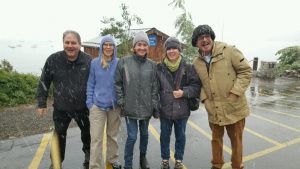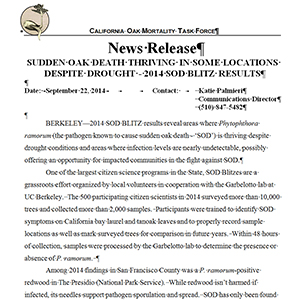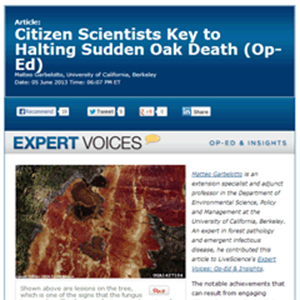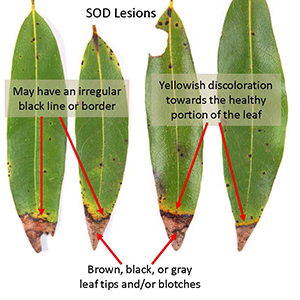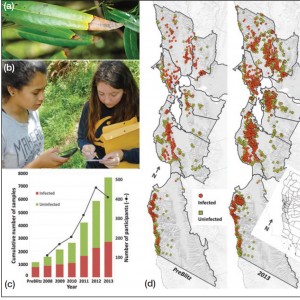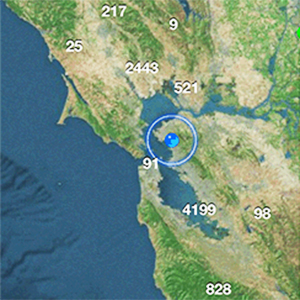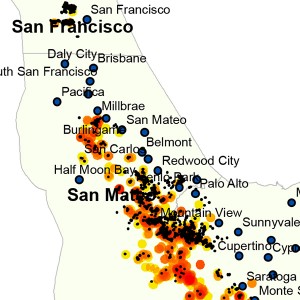Are there any P. ramorum-resistant coast live oaks or tanoaks commercially available?
Research has identified coast live oak individuals that may be somewhat resistant to SOD, possibly because of the presence of some chemicals in the bark and phloem. However, there is no information yet on how genetics and the environment may affect this trait.
Tanoak has some mother trees that produce SOD-tolerant seedlings and some that produce seedlings that respond very well to phosphonate treatments. These tanoak families are at UC Berkeley, but are not currently commercially available.
Can the Garbelotto lab analyze wood chips for pathogens?
Armillaria is slowly killing my Thuja hedge. What is a comparable replacement hedge that will give me the same amount of privacy and be resistant to this fungus?
The first question to ask is what type of irrigation is being used currently on the hedge. Most landscape oak root fungus problems are due to overwatering in summer months. However, Thuja orientalis (=Platycladus orientalis) is quite susceptible to Armillaria even without heavy irrigation as highly susceptible species do not require excessively high soil moisture to be killed.
Prior to any new planting, as much of the old hedge (including roots) should be removed. In addition, any other decaying wood should be removed. Replanting with plants that do not require supplemental watering is best. Some CA natives that make good hedges include: ceanothus, island mountain mahogany, manzanita, and toyon. Non-native possibilities include Leyland cypress and Japanese privet. Keep in mind though that even plant species listed as resistant to oak root fungus will die if overwatered.
If the stump of a felled tree is left in place, can the roots to continue to grow?
A lot depends on when the tree is felled. If a tree is cut in winter, it is possible that the root system will experience an additional year of growth. What happens to the root system depends on many variables, including soil type and presence of other trees of the same species adjacent to the one being felled. If the same species is present and the root systems of neighboring trees are grafted, the roots may be kept alive by trees still standing. Some species, like aspen, will actually sprout new shoots along the root system. Often a stump with roots that are alive will seal the cambium on the stump surface, resulting in a round bump along the entire circumference of the tree right over the cambial area (i.e. just inside the bark).
What are the modifications required for drone canopy leaf sampling?
- Make sure the prop blades are protected.
- Modify the tail to include a collection device. A very sharp blade at a sharp angle allows twigs to be cut off and often to remain caught in the space between the blade and tail.
- Learn how to drive the drone using the camera.
- For more on drones being used for Forestry Research at UC Berkeley, go to https://nature.berkeley.edu/matteolab/?s=drone.
What can cause leaf tip scorch on redwood trees?
Leaf tip scorch symptoms on redwood trees are found from the lower to upper canopy and include healthy leaves interspersed with brown and grey leaves or portions of leaves. Grey leaves typically have black margins into the healthy tissue.
Such symptoms are typically caused by a fungus called Pestalotiopsis funerea. They are commonly associated with drought, when rainfall occurs or when there is overhead watering around the tree. Drought stress predisposes plants to being infected, so the increased moisture facilitates the infection process. Normally the fungus will only seriously affect sprouts, as branches of adult tress will regrow areas killed by the infection within a year. In nursery settings it is important to increase ventilation and avoid big differences in watering regimes to minimize symptoms.
Which trees give off the most oxygen?
Assignment levels of oxygen emission are not precise and different methods can give different results. That said, it is well documented that oxygen release is proportional to the overall leaf mass, also known technically as Leaf Area Index.
There is general agreement that:
- Pines are at the bottom of the list in terms of oxygen release because they have a low Leaf Area Index.
- Oak and aspen are intermediate in terms of oxygen release.
- Douglas-fir, spruce, true fir, beech, and maple are toward the top of the list for oxygen release.
Other than for copper-based sprays, what control methods are available for cypress canker?
There are several products that have been tested for controlling cypress canker. The following paper maybe the most useful one to compare products.
Della Rocca, G., Di Lonardo, V., Danti, R. 2011. Newly-assessed fungicides for the control of cypress canker caused by Seiridium cardinale. Phytopathologia Mediterranea. 50 (1), pp. 65-73.
The most effective active ingredients for preventive treatments appear to be Azoxystrobin and thiophanate-methyl.
A good approach to slow down the disease may consist of:
1) Cutting down infected trees to reduce the chance of contagion. If only a few tips are infected, prune branches rather than take down the entire tree.
2) Cut down all Leyland cypress as it is a major vector of the disease.
3) Treat remaining healthy trees with products containing azoxystrobin (an active ingredient less toxic than thiophanate-methyl).
Can coast live oak be used in a large-scale Bay Area tree planting project without exacerbating SOD?
Question:
My organization is considering launching a large-scale urban tree planting project in the Bay Area, with the goal of adding one million trees to the urban forest inventory within 15 years. We are interested in coast live oak (CLO) as a major component of the effort for a number of reasons, including the ease with which seed can be collected and planted, drought tolerance, habitat value, high potential for carbon sequestration and rainfall interception, and status as a “signature tree” of the local landscape.
The plan is to gather seed locally from many locations, and plant with minimal site preparation and no supplemental irrigation or other artificial life support systems. Trees will be monitored and cared for over time, and replanting will take place as needed to ensure that we continue to make progress toward our goal. Obviously we don’t want to exacerbate the sudden oak death problem. Our hope is that, on the contrary, widespread and large-scale planting with subsequent monitoring might help identify resistant trees. What recommendations do you have?
Answer:
First of all, this is a really neat project and you are absolutely correct about the benefits of planting CLO. Based on the information provided, the following are recommendations for the project:
In addition to coast live oak, it would also be good to plant Oregon white oak in the northern greater Bay Area, valley oak in the middle portion of the Bay Area, and blue oak in the southern part of the Bay Area. The rationale for this is that diversity/biodiversity is always good and the three alternate oak species are immune to SOD. A good overall planting ratio would be 75% CLO and 25% other species.
The big issue is going to be when California bay laurel is present, as it helps to spread Phytophthora ramorum. CLO should never be planted within 20-25 yards of bay for this reason. Unfortunately, bay has become invasive and SOD is actually increasing its abundance, so where bay is at least 10% of the stand, plant the other oak species recommended above. In riparian areas, bay should be left untouched.
When will the 2017 SOD Blitz and training sessions be held?
SOD Blitzes include a training session for blitz volunteers on SOD and proper sampling, followed by time in the field for collecting and marking sample locations. All necessary collection materials are provided to volunteers during the training session for use either the same day of the training or the day after. All samples are to be dropped off at a designated location (location announced at the training session). There are approximately 20 SOD Blitzes in areas of California that have sudden oak death or at risk of disease establishment. Most of the training sessions are offered on Saturday mornings. SOD Blitz schedules for the coming year are posted annually during the last week of January at www.sodblitz.org.
My redwood has severe dieback and is near a coast live oak with SOD. Could the redwood have SOD?
Most likely the redwood is experiencing symptoms related to cycles between drought and rainy periods. However, if there is a significant presence of California bay laurels intermixed with redwoods, there may be enough pressure from the SOD pathogen to also cause problems on redwoods, both native and exotic. Any SOD oak infections are likely directly connected to bay laurels, as both oaks and redwoods can become infected by the large number of spores produced on bay laurel leaves. The pathogen does not move from oaks to other trees.






